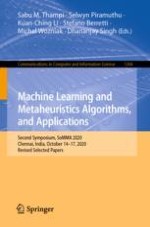2021 | Book
Machine Learning and Metaheuristics Algorithms, and Applications
Second Symposium, SoMMA 2020, Chennai, India, October 14–17, 2020, Revised Selected Papers
Editors: Prof. Sabu M. Thampi, Selwyn Piramuthu, Dr. Kuan-Ching Li, Prof. Stefano Berretti, Prof. Michal Wozniak, Dr. Dhananjay Singh
Publisher: Springer Singapore
Book Series : Communications in Computer and Information Science
